Death is always sudden. When you hear of the death of someone dear to you in Japan, you may suddenly feel at a loss about how to treat the deceased and their family as you’re not familiar with the culture. How to give condolences? What is appropriate to say? Want to attend the funeral but don’t know how to dress or what to do?
Losing someone is hard, and surely you’d want to convey your feelings and properly mourn them. Or perhaps be there as support and comfort for someone who has suffered a loss. For those of you who have the heart and compassion to learn Japanese funeral traditions, we have summarised all you need to know.
Table of Contents
- How Japanese Respond to Critical News (Informing and Receiving)
- Japanese Funeral Traditions: 5 Ways to Express Condolences in Japanese
- Japanese Funeral Traditions: Japanese Funeral Process
- Japanese Funeral Traditions: Attire, Etiquette, and Offerings
- Japanese Funeral Traditions: Memorial Service After Funeral and Death Anniversaries
How Japanese Respond to Critical News (Informing and Receiving)

危篤 / Kitoku / Critical Condition
Definition: A state in which the attending physician judges that the patient’s life is in imminent danger with no possibility of recovery.
How is news of critical conditions informed in Japan?
In Japan, when a doctor declares that someone is in critical condition, the news is conveyed to family members living together, third degree relatives, close friends or acquaintances of the person in critical condition, and if necessary, his/her workplace.
There is not much difference when it comes to the emotional aspects compared to other countries. The most important point is to inform those who are most important to the critically ill patient and those who most want to meet him/her one last time before he/she passes away. Since time is of the essence, it is best to inform people based on order of importance.
Brief stop here>> What is Japan’s concept of kinship:「 親等 shintou」?

In Japan, the degree of kinship is called「 親等 shintou」. The lower the number in front of「親等」, the closer the relationship.
- 1親等 / first-degree relatives : Parents, spouse and children
- 2親等 / second-degree relatives : Grandparents, siblings and their spouses, grandchildren and their spouses
- 3親等 / third-degree relatives : Great-grandparents, great-grandchildren and their spouses, aunts & uncles and their spouses, nephews & nieces and their spouses
In Japan, critical situations are usually reported by phone, but recently, it is also not uncommon to report by text message. In the case of phone calls, due to the exceptional situation, it is acceptable to call regardless of late night or early morning (add an apology for the inconvenient hour), or leave a message on voicemail / answering machine.
If it is difficult for the other person to come to the hospital immediately for reasons such as living far away, it is good to practise consideration by telling him/her that you will let the patient know and promise to contact them again with updates of the situation. Other things to consider is that for those coming from faraway, they would need to incur transportation and accommodation expenses, if you want to, you can offer to cover those expenses.
Moreover, break the news gently to the elderly, ill, pregnant, and women who are close to labour or have just given birth as the news may impact their health.
What to do when you hear someone close to you is in critical condition?
When seeing someone in critical condition, it is not rude to wear casual clothes or work clothes since there is an understanding that you are in a rush. Try your best to arrive at the hospital as soon as possible, and if you are visiting from faraway, it is better to come prepared to stay for several days (if packing funeral clothes just in case, do not let anyone know, especially the family).
If going by taxi is the fastest way, it would be good to know first hand How to Call Taxi in Japan and Taxi Fare in Japan. Keep in mind traffic conditions, using a taxi during peak hours may get you stuck in traffic.
訃報 / Fuhou / Obituary
A notice of death, usually in the newspapers, also called「死亡広告 shibou houkoku」. In some cases, the funeral’s details are undecided and so a “contact later” message will be included instead. Japanese expressions such as「逝去 seikyo; death / passing」and「永眠 eimin; eternal sleep」are used.
In Japanese obituaries, the name of the “chief mourner (喪主 moshu)” and their relationship with the deceased is conveyed.
Writer's Pick
Japanese Funeral Traditions: Expressing Condolences in Japanese
Just as we comfort the bereaved family by saying “my deepest sympathies” when hearing about a death, condolences are expressed by saying “okuyami (お悔やみ)” in Japan. In Japan, expressions to comfort the bereaved family, words said directly to the deceased, and expressions said in person or through text message / emails are all distinguished.
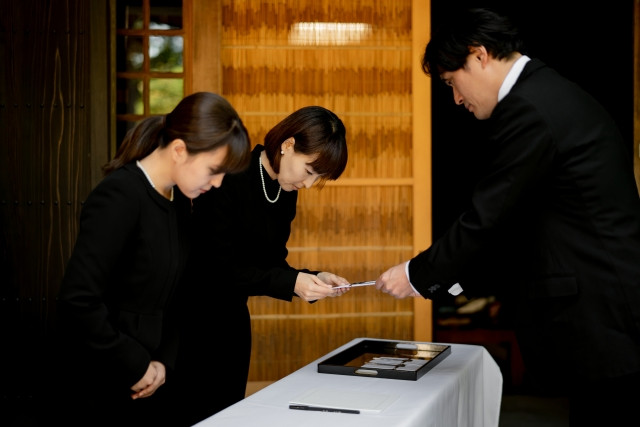
ご愁傷さまです / goshuushousama desu
「愁」means “grief”, and「傷」means “heartache (sorrow or worry)”. A general expression used when meeting the bereaved family in person is:
この度はご愁傷様です。
kono tabi wa goshuushousama desu.
- I am deeply sorry about your loss.
Be careful not to use it in e-mails or letters.
心よりお悔やみ申し上げます / kokoro yori okuyami moushiagemasu
This expression is also good for expressing condolences to the bereaved family. It means “I express my sincerest condolences.” It is suitable to use when spoken in person and also for letters, emails, and Japan’s telegram of condolence service “弔電 chouden”.
ご冥福をお祈りします / gomeifuku wo oinorishimasu
This expression means “may their soul rest in peace” and are words meant to be conveyed to the deceased. It is mainly used when writing condolence messages, telegrams, etc. For condolence expressions to the bereaved family, the above 2 expressions are more commonly used.
[Note] In Japan, 「冥福 meifuku」means “happiness in the afterlife”, so care must be taken when using it as there are religions who have no concept of the afterlife.
突然の悲報に接し / totsuzen no hihou ni sesshi
“Upon hearing this sudden sad news…” is an expression often used to start a condolence letter or telegram to express shock and sadness.
この度は思いがけないことで、本当に残念でなりません。どうかお力落としなさいませんように / kono tabi wa omoigakenai koto de, hontouni zannen de narimasen. douka ochikaraotoshinasaimasen youni.
“My sincerest condolences for this unexpected incident. I pray you do not lose strength.” is an expression used to comfort the bereaved.
When you come across an obituary of someone you know, it is best to contact to express your condolences first before requesting to attend the wake (more below). In some cases, your presence may not be appreciated for some reason such as being limited to close family only, not holding one, etc. It is best to obtain permission from the bereaved family beforehand instead of showing up unexpectedly. It is a difficult time for the deceased’s family, so please be understanding.
Japanese Funeral Traditions: Japanese Funeral Process
Japanese funeral traditions consist of a wake (condolence visits), funeral, and farewell ceremony. Although they are all meant for mourning the deceased, they are each characterised by their different purposes. In this part, we will explain the Japanese funeral process from receiving a funeral invitation to the cremation ceremony.
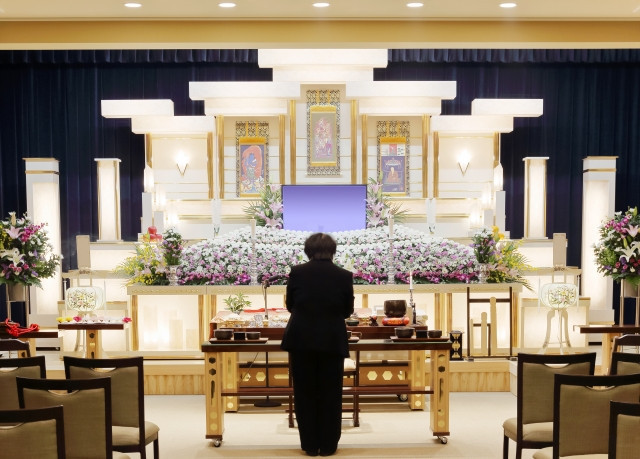
1. Receive Funeral Invitation
In Japan, it is most common to attend and pay respects at the wake ceremony and funeral. It is only possible for those with particularly close relationships to the deceased or their family that can pay a condolence visit before the wake.
An invitation letter will be sent to you once the funeral has been scheduled, so be sure to apply to your company for bereavement leave and make your preparations to attend. The invitation includes the date and venue for the wake and funeral, as well as details about where to send condolence telegrams and funeral offerings if you are unable to attend.
A reply postcard is usually attached with the invitation so you can confirm your attendance. Fill in the necessary information and reply as soon as possible. In addition, there are proper manners to follow when replying. Cross out the character「御」in front of「出・欠席」 with double lines, and change the character「行」that is next to the sender’s name to「様」 .
If the funeral notice states that the funeral ceremony is for “family only (家族葬です / kazokusou desu / family funeral)” or “please refrain from attending the funeral (葬儀への参列はご容赦ください / sougi he no sanretsu wa go youshakudasai)”, that means those who are not family or not very close to the deceased/bereaved family are not allowed to attend the funeral. In some cases, a “notice of death(死亡通知状 shibou tsuuchijyou)” is sent out after the funeral has already been held between close relatives at the request of the deceased and his family.
2. Attending a Japanese Wake
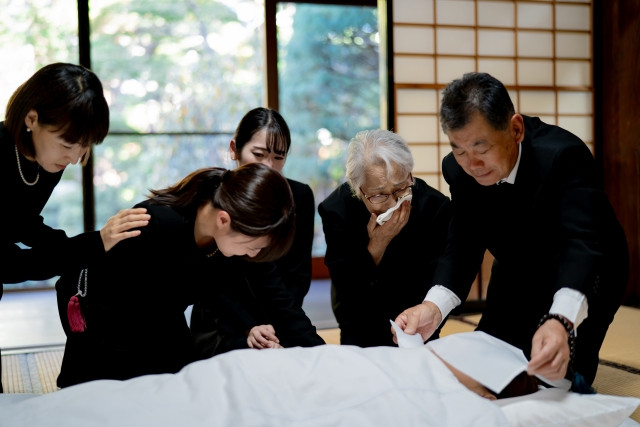
Before sending off the deceased (burial/cremation), the bereaved family, friends and acquaintances will gather to say their final goodbyes. This is called「お通夜 otsuya」. Originally, otsuya is an overnight ceremony with attendees keeping the deceased company for the last night, but nowadays it only lasts about 1~3 hours.
It is common for attendees to burn incense, enjoy food and alcohol prepared by the bereaved family for the deceased, and have a final meal together with the deceased. In the past, shojin ryori (精進料理; vegetarian cuisine for Buddhist monks) was served, but nowadays there is a moving trend towards casual dishes and meals.
The purpose of the wake dinner is to mourn and hold a memorial service for the deceased. Spend your final night with the deceased quietly, and practise consideration and manners whilst avoiding insensitive topics.
3. Say Goodbye to the Deceased at Funeral (葬式) / Memorial Service (告別式)
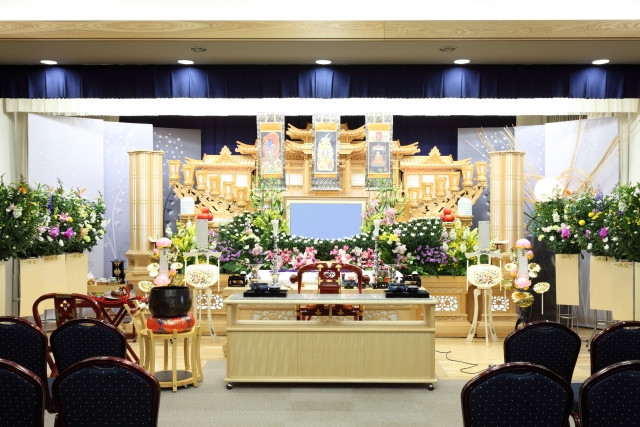
Funeral ceremonies are called 「葬式 soushiki」or「葬儀 sougi」in Japanese, the terms are used interchangeably. Soushiki, or sougi, are ceremonies where the bereaved family and attendees pray for the deceased’s soul. Since the ceremony strongly reflects religious views, in the case of Buddhism, monks recite sutras and burn incense, and in the case of Christianity, the Bible is read and prayers are offered. Funerals are usually held the day after the wake (お通夜 otsuya), and during the day for 1~3 hours. After the funeral, the body is taken out of the coffin and cremated.
On the other hand, memorial services, called「告別式 koubetsushiki」in Japanese, are ceremonies that do not involve religious rituals. After reading the condolence telegrams (and messages, and letters), the chief mourner (喪主 moshu) will give his/her greetings, and finally the burning of incense and offering of flowers.
The biggest difference between a funeral and memorial service is the presence or absence of a religious ceremony. However, it is not uncommon for the terms to be used interchangeably due to similar rituals. Even at memorial ceremonies, religious rituals may be done, so it is safest to dress and practice manners that match the deceased’s denomination.
Brief stop here >> What is Japan’s condolence telegram “chouden (弔電) ”?
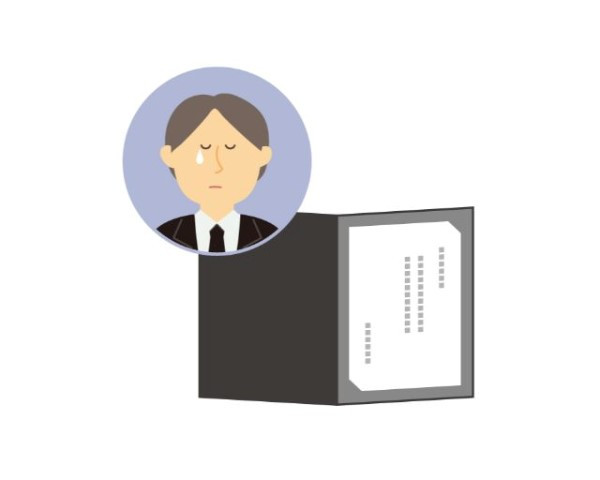
There may be cases where you cannot make a condolence visit after hearing news of the deceased even though you have a close relationship. In such a case, you can request for a proxy to attend in your stead and help you express your condolences via a condolence letter or telegram (弔電).
-
Where? Receiving address is the location of the wake or the funeral
-
When? Condolence telegram (弔電) Chouden is usually read at the farewell, so send it that it arrives by then
-
How? Chouden services can be found on the internet, select「電報台紙 denpou daishi」. In some cases, a set inclusive of incense or flowers are available. Next, compose your message. Include your condolences to the bereaved family, a short piece about your memories with the deceased or an episode in your life that shows the deceased’s good character quoting things he/she said. At the end, include your information such as name, relationship with deceased, contact information. Note that the number of characters may be limited.
-
How to address the deceased? Refer to the deceased according to his/her relationship with the chief mourner (喪主 moshu)”. For example, if the deceased is the chief mourner’s father, then「尊父さま sonpu-sama」or simply「お父さま otou-sama」.
-
[Attention] If the bereaved family has expressed their intentions to have a quiet family only funeral/wake and rejected invites to visit, it is better and respectful to not send condolence money or condolence telegrams.
If you send a condolence telegram, in many cases, a thank you note (お礼状 oreijyou) will be sent to you about a week after the funeral.
4. Transferring Cremated Deceased into Urn
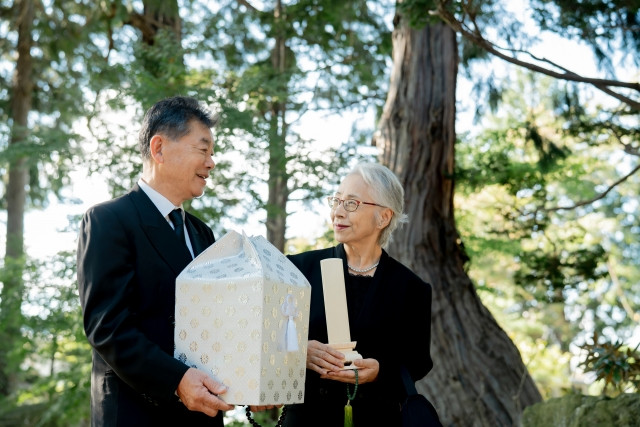
The cremation (火葬 kasou) is a ceremony only attended by the bereaved family. In Japan, after the cremation is completed, the bones will be collected, this is called「収骨 shuukotsu」in Japanese. Shuukotsu is a ritual done by 2 persons as a pair. Long chopsticks are used to lift the bones and transfer them into an urn. There is an order to this, starting with the teeth, and then from the feet to the head, and ending with the larynx which is done by the person closest to the deceased.
Generally, the bereaved family and close relatives will collect the bones, but if permission is obtained from the chief mourner, other ordinary attendees can also lift the bones.
Depending on the area’s customs, cremation may be done before the funeral ceremony. This means that you may not get to see the deceased for the last time if you arrive late to the venue. If you want to see the deceased one last time, try arriving at the venue early.
Japanese Funeral Traditions: Attire, Etiquette, and Offerings
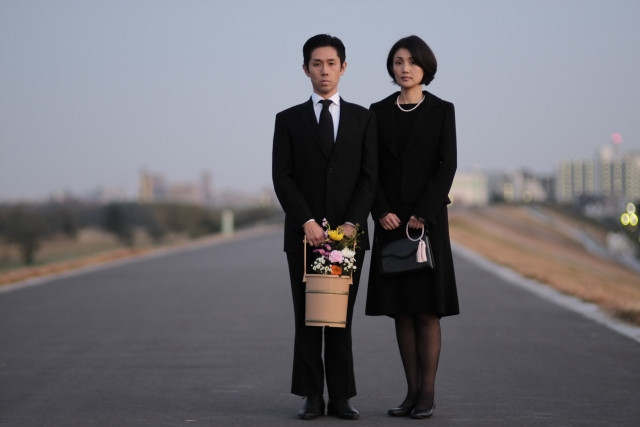
A wake and funeral are important ceremonies to mourn the death of the deceased. To properly mourn the deceased and offer comfort to the bereaved family, learn the proper Japanese funeral traditions such as funeral clothes and how to burn incense.
Death is very unexpected and you’ll never know when you’ll have to attend a funeral, so just in case of an emergency, here are Japanese funeral traditions and manners to learn in advance.
Japanese Funeral Clothes: Choose Mourning or Plain Clothes
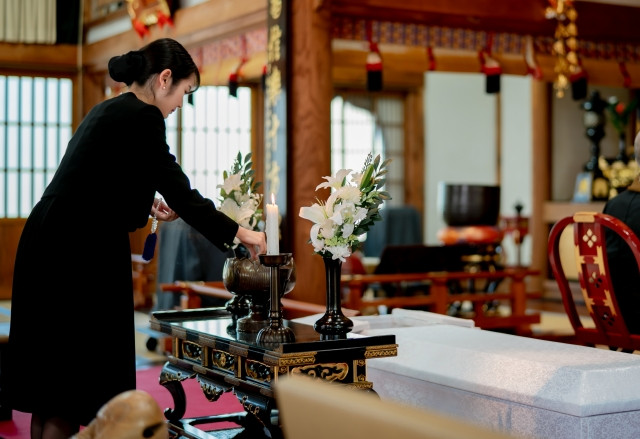
It is best to wear mourning clothes (喪服 moufuku), which is strict formal wear, but if you can’t prepare them in time, then plain dark coloured casual clothing is acceptable.
-
For men, wear a black suit with matte black leather shoes.
-
For women, wear a plain black dress with black stockings and shoes. It is best not to wear any accessories other than wedding rings, but a string of pearls or a black onyx simple necklace, and simple earrings are fine.
-
For children, school uniforms are formal attire.
The most important point when choosing your funeral clothes is to show your condolences. Choose clothing that suits the atmosphere and place so as to not disrespect the deceased and the bereaved family.
Burn the Right Incense: Follow the Deceased’s Religion
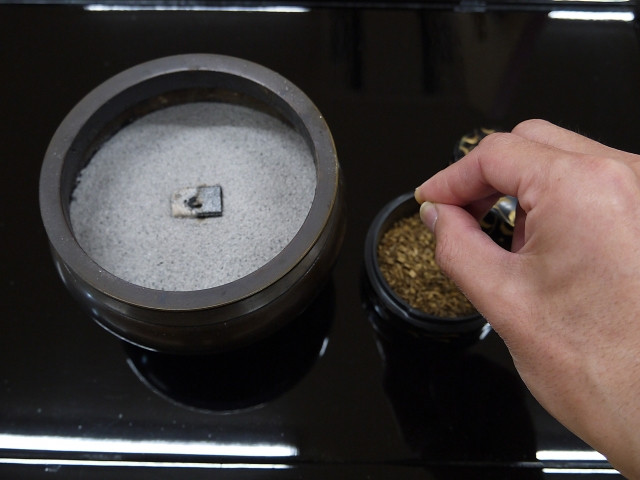
At Japanese funerals, what type of incense is given depends on the deceased’s sect. The proper customs for burning incense differ from sect to sect, so the best way is to check with the bereaved family in advance.
Generally though, it goes like this:
-
Bow to the bereaved family.
-
Hang the prayer beads over your left hand.
-
Pick up powdered incense with the thumb, index finger, and middle finger of your right hand.
-
Raise the powdered incense to forehead level, and drop the powder into the incense burner by lowering your fingers.
-
Repeat according to the number of times specified by the sect.
-
Put your hands together in front of the deceased’s portrait and bow once.
-
Bow again to the bereaved family.
In the case of burning incense sticks, light it with a candle, and when smoke appears, fan it with your hand to extinguish the flame. As with powdered incense, bow to the bereaved family before and after offering incense, and also put your hands together in front of the deceased’s portrait and bow once after you’ve offered incense.
Preparing A Funeral Offering: Koden (Condolence Money) and Japanese Funeral Envelope
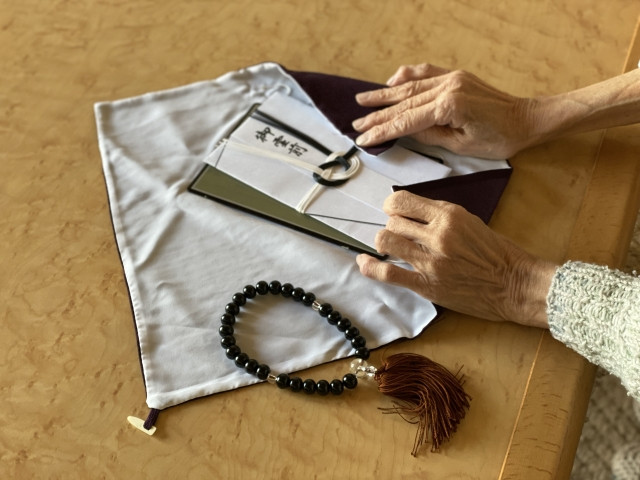
「香典 koden」is Japanese condolence money as payment for incense to be burnt to honour the deceased. The money is placed in a non-gift envelope (香典袋 kodenbukuro) and then wrapped in a small silk cloth (袱紗 fukusa). There are 3 ways to write a Japanese funeral envelope: Buddhist, Christian and Shinto style, so be sure to check before preparing.
The appropriate amount to offer depends on your relationship with the deceased. The further the relationship with the deceased, the lower the amount, and the closer the relationship, the higher the amount. 10,000 yen is recommended for relatives of the deceased, and 5,000 yen for friends, acquaintances, and co-workers of the deceased.
It is good etiquette to use old used bills for condolence money, but if you only have new bills, then you can use them by folding them vertically. When handing over the funeral envelope containing the condolence money at the reception, start by expressing your condolences and then handing over the funeral envelope taken out of the fukusa.
Send Condolences If You Cannot Attend: Condolence Telegram
If you are unable to attend the funeral due to sudden news of the death, it is customary to send a telegram of condolence (check above). Arrange for the telegram to arrive by the day before the funeral, and addressed to the chief mourner of the bereaved family. When writing the telegram, pay attention to your words (check below) and be careful not to upset the bereaved family.
Be Considerate of Your Words: Avoid Sensitive Topics
The most important thing is to be considerate of the bereaved family. Avoid asking intrusive questions about the cause of death, the circumstances at that time, and how the deceased was leading up to his death. You should also avoid bringing up bright happy topics like childbirth or marriage even if it's to lighten the mood.
Speaking of which, when it comes to condolence letters, telegrams (below), emails, etc. avoid using these expressions / words:
-
「重ね重ね kasane kasane」, 「追って otte」, 「続く tsuduku」, 「度々 tabi tabi」, etc. words that imply continuing and repeating misfortune
-
「四 shi」which sounds like「死 shi」meaning death
-
「九 ku」which reminds people of「苦労 kurou」meaning hardship
-
「死ぬ shinu; die」, use 「ご逝去 goseikyo」meaning passed away instead
And finally, use the correct terms for the deceased’s religion. For example, avoid saying “heaven (天国 tengoku)” if the deceased is a Buddhist. This is also part of consideration for the deceased and the bereaved.
Japanese Funeral Traditions: Memorial Service After Funeral and Death Anniversaries
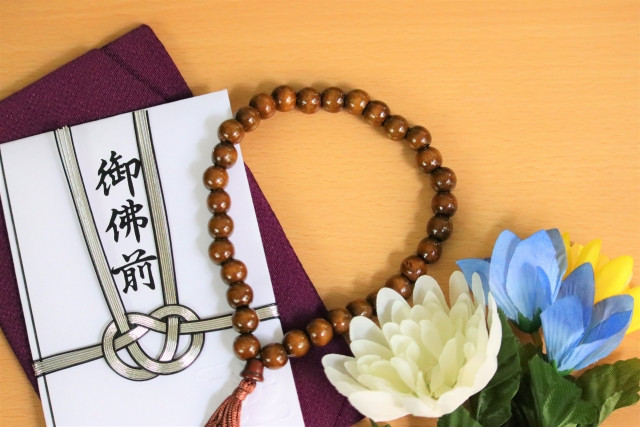
Even after attending the funeral, there is a possibility that you will be asked to join a memorial service on the 7th day or 49th day after the funeral, or the first anniversary of death. You should have no problems attending the memorial service if you know Japanese funeral traditions. The only thing you should know is that the wrapping of the Japanese funeral envelope and your attire is different.
7th / 49th Day Memorial Service
Dressing and funeral envelopes are the same for the funeral when attending 7th or 49th day after funeral memorial service.
The decorative cord (水引 mizuhiki) of the funeral envelope is double silver, or black and white, and on the top of the envelope is written「御霊前 goreizen」, which means “before the spirit of the deceased”. The amount of condolence money is determined by the relationship with the deceased, so it can range from 5,000 yen to 100,000 yen.
Note that the 7th day after the funeral memorial service is often held at the same time as the funeral ceremony.
1st and 2nd Year Death Anniversary
The first year anniversary of someone’s death is called「一周忌 ishuuki」in Japanese, and the second year anniversary is called「三回忌 sankaiki」.
On the first and second year anniversaries of the deceased’s death, it is customary to attend in informal dress or casual clothing but in dark tones. Black, navy, and grey are suitable colours. Accessories that can be worn are the same as those allowed at funerals.
For the funeral envelope’s decorative cords, black and white, or double silver is used, same as above. Though in the Kansai and Hokuriku regions, yellow and white cords are acceptable. On the top of the envelope is written 「御仏前 gobutsuzen」,「御佛前 mihotokemae」, or「御供物料 okumotsuryou」. The condolence money amount is again based on relationships. For friends and acquaintances, the range is 3,000 ~ 10,000 yen, and for close relatives around 100,000 yen.


































